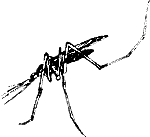| Encephalitis Bites the
Big Apple (New York City!) West Nile Virus in the U.S. |
| Encephalitis Bites the
Big Apple (New York City!) West Nile Virus in the U.S. |
|
By Ellen Kuwana Neuroscience for Kids Staff Writer October 7, 1999
Pesky Mosquitoes!No one likes being bitten by a mosquito and residents in New York City are taking extra precautions to avoid mosquitoes. Why the fuss? At least 37 people have been infected and five people have died from a viral brain disease that is transmitted by mosquitoes.
A New VisitorNew York City is home to millions of people, and now it can add one more visitor: the West Nile virus. This virus was first detected in Uganda in 1937. Although it has never been seen before in the Western Hemisphere, the virus could have been in the U.S. and stayed undetected. Nevertheless, Dr. Tracey McNamara, a pathologist at the Bronx zoo, helped to determine that the West Nile virus was responsible for the disease. How did it get here? Birds are the primary reservoir for the virus, although they do not always get sick. When a mosquito bites an infected bird and sucks up viruses along with blood, the mosquito becomes a carrier of the virus. When the mosquito bites a human, the virus can be passed on and the person may get sick. |
What Does the Virus Do? The virus causes encephalitis or swelling of the
brain. Flu-like symptoms are common in people with encephalitis.
Encephalitis may cause brain damage, coma and even death. Diagnosing and
treating encephalitis quickly can greatly reduce the chance of coma and
death. Some people who are bitten by an infected mosquito may not have any
symptoms; others may get a fever and feel sick for a few days. Other
people may not be so fortunate. They may suffer from rashes and swollen
lymph nodes. More serious infections can lead to stiff necks,
disorientation, tremors, coma and paralysis. It is estimated that the
disease kills 3-15% of those who become infected. Those with weakened or
immature immune systems, such as the elderly or infants, are most at
risk.
The virus causes encephalitis or swelling of the
brain. Flu-like symptoms are common in people with encephalitis.
Encephalitis may cause brain damage, coma and even death. Diagnosing and
treating encephalitis quickly can greatly reduce the chance of coma and
death. Some people who are bitten by an infected mosquito may not have any
symptoms; others may get a fever and feel sick for a few days. Other
people may not be so fortunate. They may suffer from rashes and swollen
lymph nodes. More serious infections can lead to stiff necks,
disorientation, tremors, coma and paralysis. It is estimated that the
disease kills 3-15% of those who become infected. Those with weakened or
immature immune systems, such as the elderly or infants, are most at
risk.Although the West Nile virus usually does not affect the birds that carry it, many infected birds are dying. In New York City, more than 700 wild birds, mostly crows, have died. Approximately 20 birds, including a bald eagle and five Chilean flamingos, have died at the Bronx zoo from the West Nile virus. These deaths may mean that the virus is getting stronger, or more virulent.
How Did the Virus Get to the U.S.?Because birds generally do not migrate across the Atlantic Ocean, no one knows how the virus reached the U.S. It could have come from an imported bird or from an infected human. Either way, a mosquito got more than just a tasty blood meal when it bit into the infected host.
What's to be Done? New York has been spraying pesticides to decrease the number of
mosquitoes. It is estimated that the mosquito density has been decreased
by about 90%. There is a chance of the virus spreading as infected birds
fly south for the winter. The virus is not spread from person-to-person or
from bird-to-person. Rather, an infected mosquito must bite a person to
transmit the virus. So far no cases have been reported outside of New
York.
New York has been spraying pesticides to decrease the number of
mosquitoes. It is estimated that the mosquito density has been decreased
by about 90%. There is a chance of the virus spreading as infected birds
fly south for the winter. The virus is not spread from person-to-person or
from bird-to-person. Rather, an infected mosquito must bite a person to
transmit the virus. So far no cases have been reported outside of New
York. |
Virus Carriers
|
|
References:
|
| BACK TO: | Neuroscience In The News | Table of Contents |
![[email]](./gif/menue.gif) Send E-mail |
 Fill out survey |
 Get Newsletter |
 Search Pages |